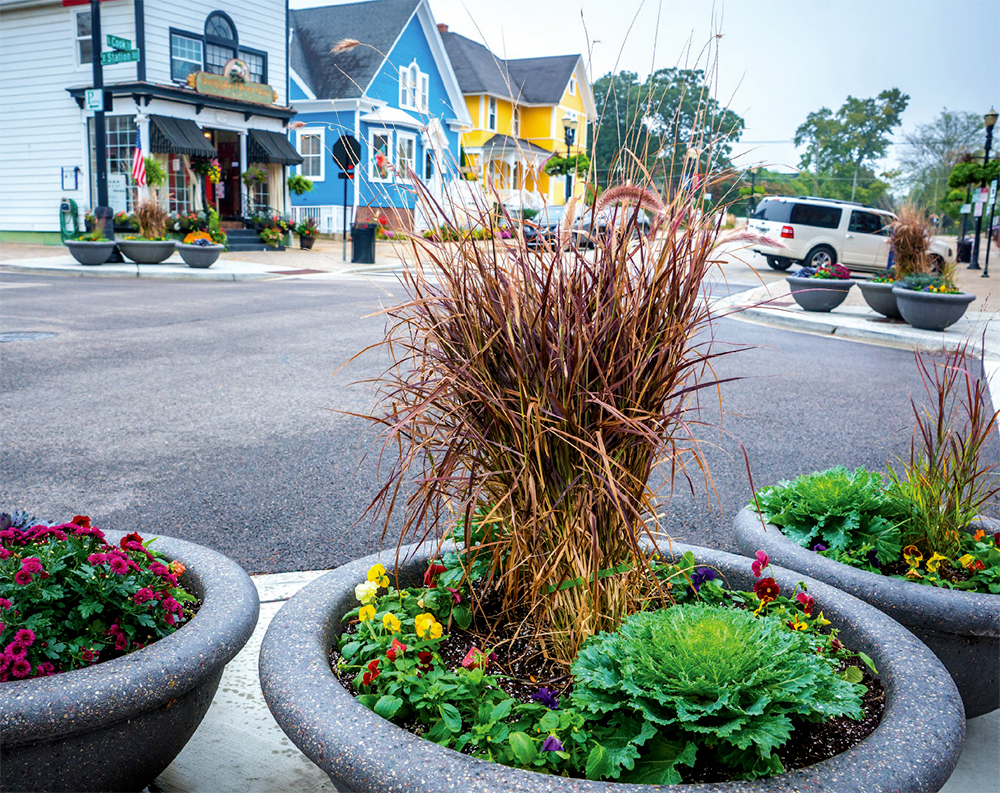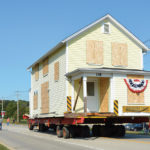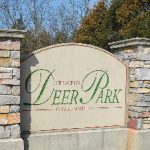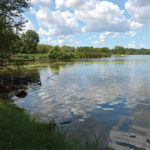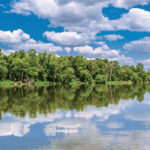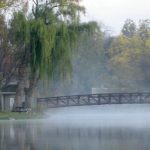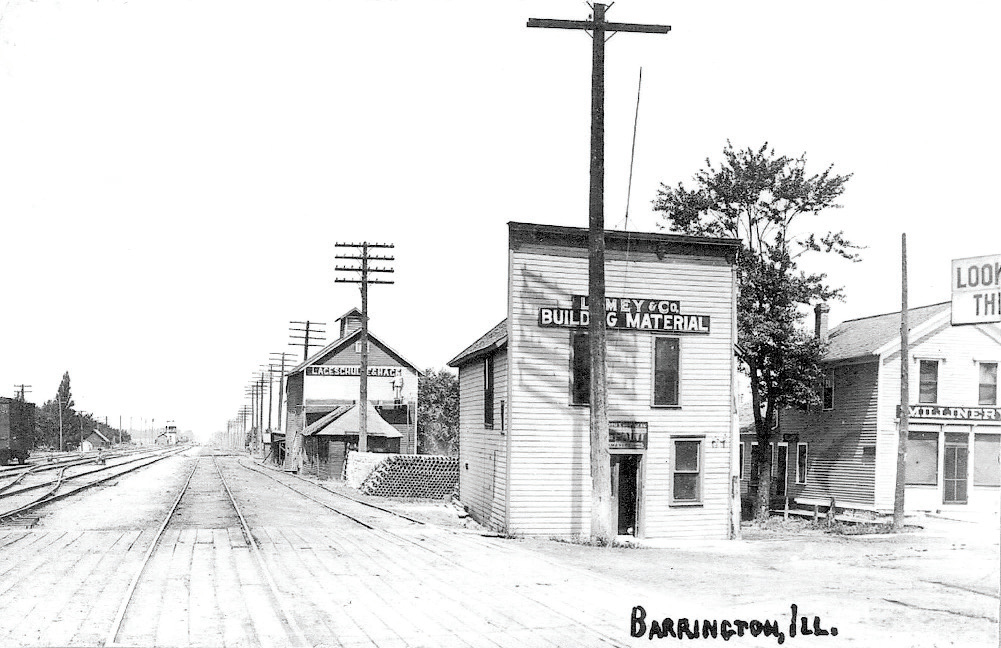
Edward Lamey’s store at the corner of North Cook Str eet and the railway line. Here, the first newspaper was printed in Barrington. At the building behind it, there appears to be a man on a scaffold getting ready to finish the sign on that building to read “Lageschulte and Hager”.
A Crossroads Becomes a Town
Long ago, Winston Churchill said: We shape our buildings, and thereafter, they shape us. That may well be true of Barrington—but the popular axiom, ‘if you build it, they will come’, has a reverse to it here. The people were coming. Then, laying claim to plots of land, Barrington’s earliest settlers cut down trees, built cabins, and took up farming. Building general stores, livery stables, and banks came only after they had planted their roots in the soil, and in the community. Since that time, Barrington has evolved through ongoing seasons of creation, preservation, imagination, restoration—all with a unique community spirit and sense of stewardship about a special place.
Building Barrington
There wasn’t much to see. A few shanties, some railroad lines, and a modest train depot that had been moved on a flat car along the line—literally as the rails were laid. Even a few houses were to be moved along the line from their previous locations. In 1854, they would become the nucleus of a town first known as Barrington Station.
In 1855, as the town limits extended north of the county line road into Lake County, a resilient Irishman named Edward Lamey decided to buy a small village plot on what is now Franklin Street. His family had left the old country a few years before, winding up in Chicago. So did the Byrne family. Julia Byrne was Ed Lamey’s sweetheart, but they had lost touch. As a devoted Catholic, Ed suspected that a good way to find her would be to attend all of the Catholic services in Chicago, and he was right.
A Memorable First House
Julia and Ed Lamey were married, and came home to 328 Franklin Street, the first milled lumber house to be built in the town of Barrington. From then until 1873, the house, as recorded by descendants of the Lameys, was the place where masses were held on Sundays by a circuit-rider priest from Woodstock, Illinois.
In 1855, the Methodist congregation from Barrington Center (at Dundee and Old Sutton Roads) saw many countryside pioneers move to the new town. They built a church on Ela Street. During the next few years, the Methodists outgrew the church, and in 1873, the Catholics took the opportunity to buy it and establish their new Parish of Saint Anne. The significance of 328 Franklin Street was two-fold: first, that milled lumber was shipped via the railroad before a sawmill existed in the area, and second, that a residence was used as a house of worship, founding a parish that became an integral part of the community’s religious and educational life to this day.
The Lameys prospered in the town. Their son, Miles, published the first edition of the Barrington Review newspaper in 1889. More people moved into the few streets that were platted out around the County Line Road where the railroad lines were steadily being laid diagonally to the northwest. By 1863, the population had reached 300, the number for incorporation, and, on November 18, 1863, at a meeting in the old depot, the vote was taken to apply to Springfield for the legal establishment of the Village of Barrington Station. The vote was 29 for incorporation and four against. The charter was granted on February 16, 1865.
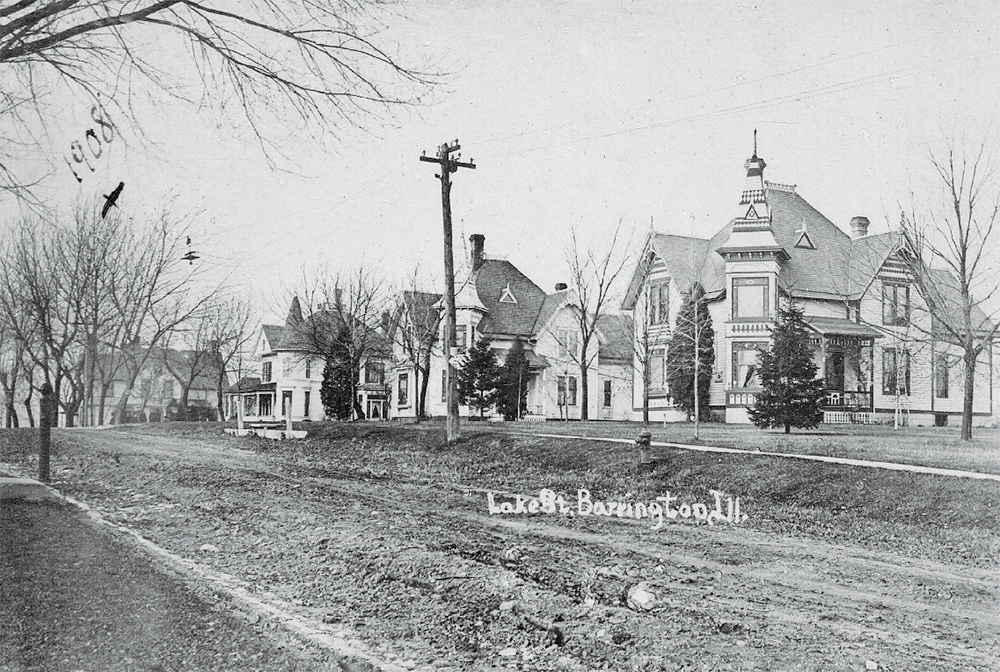
Barrington’s “Gold Coast” showcases three Victorian houses on Lake Street seen here
in a 1908 postcard image. Photo Courtesy of Ken Munson.
Ramshackle and Rickety
As a community at that time, it was a ramshackle place, reminiscent of a western gold rush town. Houses were modest frame structures, with their outhouses in the backyard. The streets were either muddy or dusty, and businesses functioned in similar type buildings, raised up above the sidewalks and entered by rickety wooden steps. A few photos exist of this period, and indeed, some of those buildings are still around, moved to other locations when Barrington’s “building moving” boom flourished, propelled by the expertise of the Scherf family, known as efficient building movers.
Barrington historian Arnett C. Lines described Barrington in 1888: “When the community was but 34 years old, let us recall its appearance. In wet weather it was a floating sea of mud, mud, mud. Crosswalks were usually of plank, except downtown where rectangular Bedford limestone soon began to be used. Later on, the police officer, who usually had charge of the streets, used to shovel the mud from the crosswalks, especially from the bank corner northeast to the old depot, for the few coming home from Chicago on the later afternoon paper train. In dry weather, the dust which was copiously perfumed with horse manure from the streets blew through the village in clouds.”
Barrington’s Gold Coast
But that same year, 1888, the village began to take on a more substantial and prosperous appearance, a center for trade from the surrounding countryside, where dairy farms and cheese factories were added to crops and livestock in the last quarter of the 19th century. The village borders expanded.
Milius B. McIntosh, lawyer, lumberman, first-elected and long-serving Village President, started to plat and sell very attractive lots on land that he owned west of Hough Street, which was his cow pasture. This was to be named West Lake Street, and to the south, West Lincoln Street.
Many of the McIntosh buyers were retired farmers, moving in from the countryside. Jerome Kingsley was a longtime civic leader who took the first lot at 114 West Lake Street. The town’s successful businesspeople availed themselves of the opportunity to build away from the town center’s bustle and dust. The Levi Higleys, the Freemans, and Hawleys and successful realtor Sanford Peck were among the early residents of Barrington’s “Gold Coast.” The builder of choice for West Lake Street was McIntosh’s son-inlaw Fred Lines, who built his family’s home at 126, where his daughter Jennie lived until her death in 1984, and 130 for his son Arnett. As the street opened westward, craftsman bungalows and foursquare styles were added to the streetscape.
Simultaneously, more substantial residences were in-filling the lots on South Hough Street, South Cook Street, and Grove Avenue. Tree-lined streets attracted notable residents such as John Plagge, Dr. Cort Kendall, and M.B. McIntosh. It was a pleasant stroll from home to downtown. Fred Lines’ signature work as a builder was to be in 1898, when he built 145 West Main Street for banker John Robertson and his wife, Julia. To this day, it remains the most magnificent house in the center of Barrington and the only one incorporating Classical Revival style. The scale and the size of its rooms are remarkable for its context in a town that was increasing in prosperity yet was not a wealthy community.
Robertson had retired to Barrington from extensive family farms in Lake Zurich, and his banking endeavors culminated in his presidency of the First State Bank of Barrington, which closed in 1932, long after Robertson’s death in 1918. It is possible that his wife, Julia Parker Robertson, had something to say about the residence on Main Street. Local gossip had it that she had the largest house and car in town and aspired to the largest wash by having her maid string it lengthwise on the line!
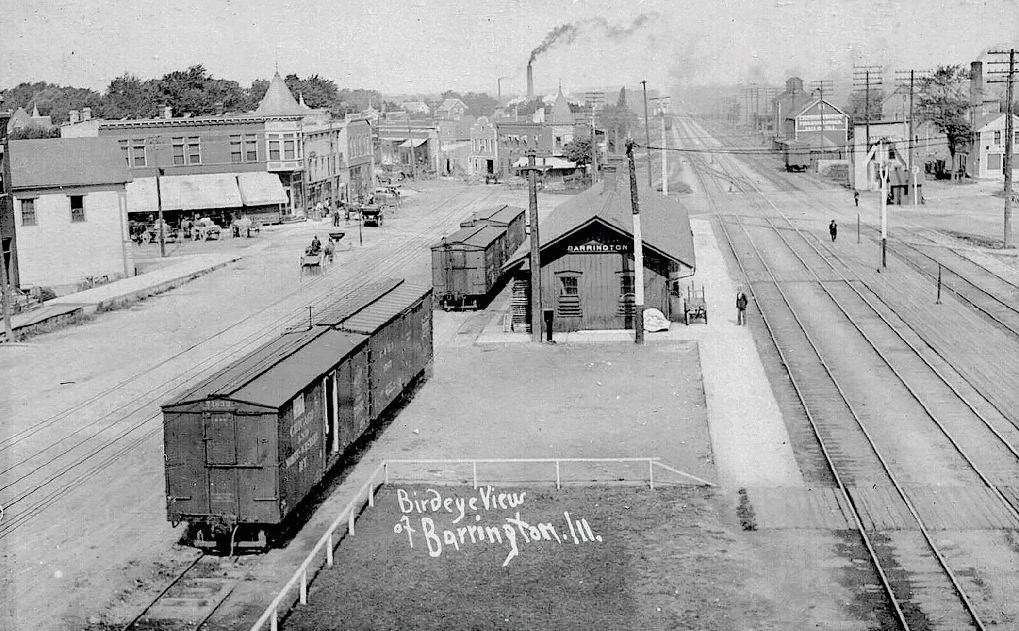
Barrington’s original social media expert, George Froelich, Jr., may have stood on the water tank by the train station to photograph this image in 1909. Photo Courtesy of Ken Munson.
The Eight-Sided House
As the town limits extended to Dundee Avenue at the beginning of the 20th century, a mix of foursquare, craftsman, cottage, and Italianate-style houses made for an interesting and varied streetscape, in which there was another rarity. The evolution of an octagonal rubblestone foundation into a residence is unclear. The style had been promulgated in the 1850s, in New England, by eccentric architect and phrenologist Orson Squire Fowler. It is known that sometime in the 1880s, Joseph Putnam Brown and his wife, Emaline Hawley Brown, took up residence on that West Main Street site. The Browns were from that area in the Connecticut River Valley where some of Fowler’s original octagonal residences were located. Brown’s ledger survives, and its first entries were made when he was still in New England. After a break, he continued in Barrington in 1855, recording numerous purchases of lumber around the time of his move into the Village. The surviving letters of Emaline Brown and her daughter, Hattie Brown Porter, mention how difficult it was to keep the “piazzas” clean, that they were always covered with fly specs. Emaline wrote that she “wished Pa had not built so many piazzas.”
As the 20th century moved on, another generation of Hawleys, closely related, moved into what was considered an unremarkable “round” white-painted house, until, around 1980, a new owner, F. Parker Sharpe, taking advantage of tax credits for historic restoration, asked local architect Linda Grubb to apply for a National Register of Historic Places nomination, and to undertake a certified historic restoration. In the course of this work, paint analysis revealed that age and habit saw only the “round” white house, and not underneath, the original colors that distinguish the building today.
Opening Up a Business District
Both business district and residential styles of architecture were slow to change. Some of the change was from necessity, when several fires in the 1890s destroyed the frame stores and livery stables downtown. They were replaced with two-story brick structures that were typical of the time. The frugality of the Yankee and German pioneers of the area manifested itself as other buildings that became outdated were moved. Frame stores and houses were “recycled” to newly opened streets, mostly west of downtown. This occurred when West Main Street was opened for business development in the 1920s, and gradually some of the late Victorian-era houses on the north side, from Hough Street west to Applebee Street, were transported by the Scherf family and their crews to other locations.
In the early 20th century, the Tudor Revival was extensively used nationwide in both residential and commercial buildings, but rarely in Barrington. It is found in the Catlow Theater block, and on East Main Street where it curves into South Cook Street. Small apartments occupied the second floors, accessed by narrow, steep stairs.
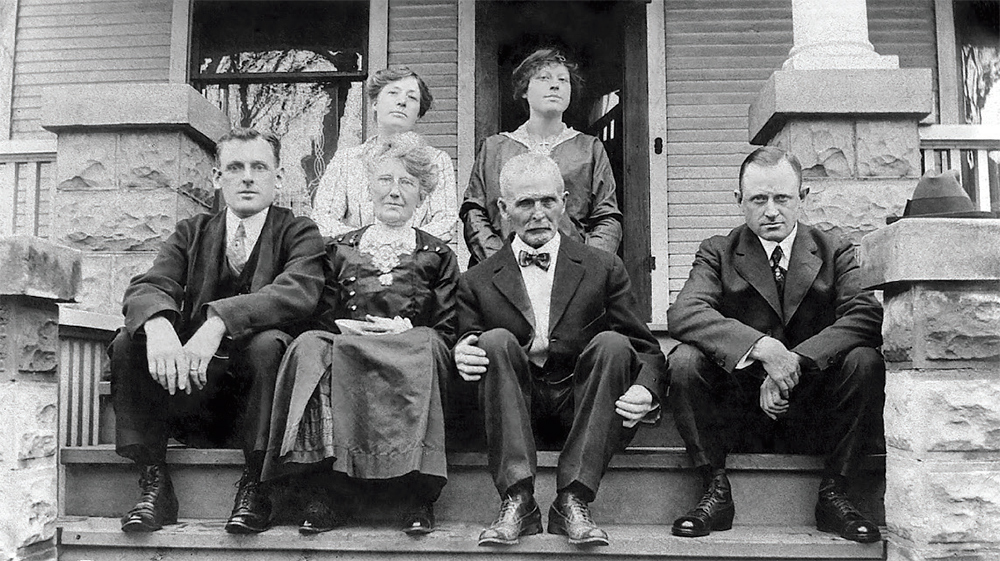
This Lines family portrait was taken in 1915 on the porch of the Arnett C. Lines’ house at 126 W. Lake Street, next to Fred Lines’ home at 130 W. Lake Street. Fred Lines was the architect and builder of the John Robertson home that is now Barrington’s White House. His son, Arnett, was Barrington’s foremost historian. In front, from left: Arnett, Emma (mom) and Fred (dad) and older brother Max. In back, from left: Viola and Jennie Lines. Fred Lines was age 66 in this photo, which was taken three years before his death. Photo Courtesy of Tim Dunn.
The “Music” of Progress
Most of the utilities representing a modern community infrastructure came into Barrington in the late 1890s, all well-documented by Emaline Hawley Brown from her vantage point in the Octagon House as she wrote to her daughter Laura in Minnesota. “We have music all around” were her words for the hammers and drills. The Brown family joined the crowds in 1889 watching the EJ&E Railway lines being laid through town. Those were often noisy and raucous days.
Perhaps the greatest change to the easy-going town was the acquisition in 1929 of the Kampert farm by Chicago’s Jewel Tea Company. The addition in 1930 of a five-story granite-grey building to the skyline was a shock to the sensibilities of many residents. But this brought jobs to the community in a time of nationwide depression.
After the Second World War, a new phase of building, sometimes described as Colonial Revival, crept in between the remaining structures of the early town. In those years there was little reference to historic preservation and the early architectural styles. But the town had one priceless inheritance—its residents. The second- and third-generation descendants of the pioneers still ran the businesses, sat on the village boards and committees, and were leaders in the many churches and school boards. Hawley, Kingsley, McIntosh, Lamey, Lines, Sandman, Waterman, Grebe, Klingenberg, Lageschulte, Plagge, Landwehr, and Schwemm, were among the families who knew firsthand how their parents and grandparents had first broken the prairie, seen a railroad connect a settlement to the world, and then build a town.
But with Quaker Oats, American Can Company, General Electric Capital, and other larger business enterprises finding a desirable location in Barrington, there were newcomers bringing vitality to community life, and a need for new housing. The village limits expanded to encompass new subdivisions. Fox Point, Westwood, Glen Acres, Chippendale, Wyngate, Hillcrest Acres, and in the 1980s Steeplechase and Tall Trees, were all expanding the village boundaries.
Historic Places and Preservation
Yet, there were many who valued the older residences located in the historic streetscapes of the original village boundaries. The Octagon House restoration was the catalyst for interest in historic preservation and restoration.
In the mid-1980s when the Barrington Area Historical Society organized activities to celebrate National Historic Preservation Week with walking tours and programs to celebrate the village’s social, architectural, and neighborhood heritage, West Lake Street became the focus of further restoration activities.
The interest from homeowners, local organizations, and village government in the community’s building heritage was such that with broad support, the Historical Society was able to engage the leading historic preservation firm of Hasbrouck Hunderman to undertake a Historic Buildings Survey, which resulted in 1986, in the nomination of a large section of the Village to the National Register of Historic Places.
Since that time, style, scale, and the impact on the streetscape have played an important part in determining all aspects of building in the village, whether it is new construction, or rebuilding and restoration of older residences and commercial buildings.
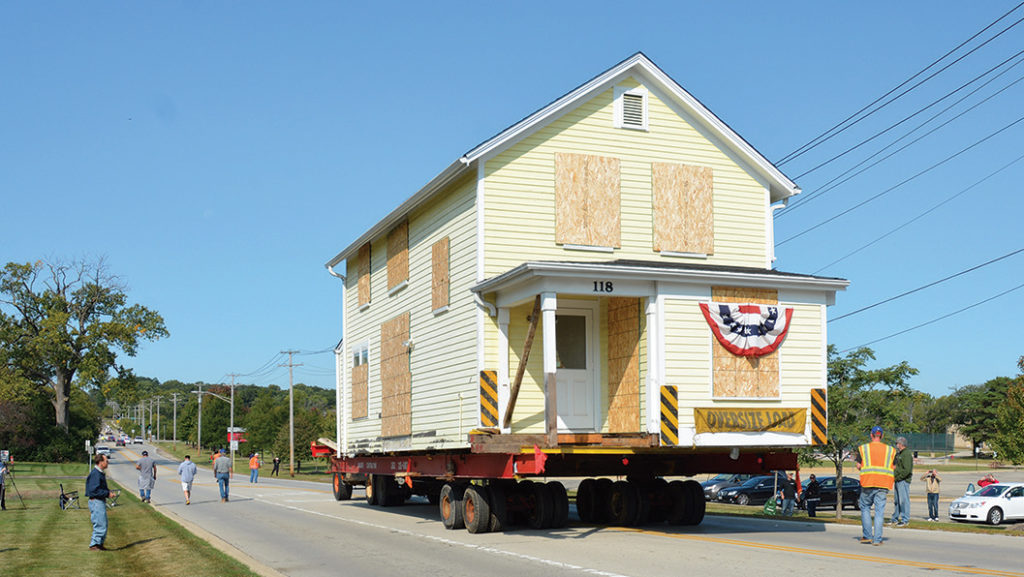
In the early morning hours of September 10, 2017, the small yellow house that started its journey from 118 Wool Street began a slow and careful move to its new location on Oakdene Road in Barrington Hills. In the old days, many homes were moved from one site to another in downtown Barrington.
Barrington’s Earliest Recycling Program
Barrington began with relocated buildings. Historian Arnett C. Lines kept meticulous records of almost every aspect of moving buildings. In fact, the original wooden depot was moved from Deer Grove almost as soon as the rails were laid in 1854. The Friend Brothers store was also moved from Deer Grove, this time in early winter, by 32 yoke of oxen, with five yoke going ahead to plough a way through the snow. The store was set down east of the railroad on Main Street.
Thomas Creet was next, as his house and blacksmith shop were also loaded on a flat car, brought from near present-day Inverness, and
relocated at the southwest corner of Cook and Station Streets. The household and blacksmith shop contents were moved along with the buildings, and eye-witnesses reported that the stove stayed lit during the entire journey. In 1921, this same house was moved to 201 West Station Street, and thus may be the oldest house in Barrington.
Hough Street School Is Subdivided
Recycling buildings in Barrington became a regular event when August “Foxy” Scherf acquired a tractor and jacking equipment to mechanize the process. One of his most intricate jobs occurred in 1905, when the white frame (first) schoolhouse on Hough Street was broken into four sections, each to be repurposed as a residence. Of the four sections, the west wing of the original 1855 village school became 121 West Station Street, later demolished as more municipal buildings were needed. The south wing, added in 1883, was moved to become 316 Dundee Avenue. The center wing, another 1883 addition, became 310 Dundee Avenue, and the north wing went across town to North Avenue, first used as a residence, and in later years enjoying fame as The Greenery Restaurant, now Farmhouse on North. The Dundee Avenue houses have recently been extensively remodeled.
The northern end of Dundee Avenue became the location for houses salvaged from Chicago Highlands neighborhood after a large foundry along the tracks closed in 1905. Nos. 200 and 216 came from the Highlands, as did 316 West Lake Street and 120 West Station Street, now demolished.
The village expanded its commercial center along West Main Street in the 1920s, when several houses were relocated, such as Lewis Bute’s house from the NW corner of Hough and Main to 108 N. Raymond Avenue where it retains its ornate façade. Moving as opposed to demolition was still in vogue during the 1950s.
When the new Post Office was built at the corner of Main and Applebee Streets, and plans were made for the new Jewel Food Store, several residences were moved to side streets farther west from there.
Modern Day Moves
In our times there have been four significant moving operations. First in 1978, a festive atmosphere prevailed when the 1915 brick train station was inched across town to become part of Al Borah’s restoration of the Ice House on Applebee Street, and to enjoy new life as Chessie’s Restaurant. In 1986, the 19th century residence at 201 S. Grove Avenue was moved to 210 S. Cook Street where it became an antiques store. The site on Grove Avenue was opened up for the new First National Bank of Barrington building.
A third significant building move took place in 1999, when again, crowds gathered to watch the Wichman Blacksmith Shop moved from West Station Street to the Barrington Area Historical Society campus on West Main Street, for a new life as an archival and exhibition center.
The fourth recent move occurred in the early morning of September 10, 2017, when a small yellow house, previously known as 118 Wool Street began a journey across Main Street to its new home on the property of filmmaker Jeff Baustert. In order to fulfil the parking needs for the new Moretti’s restaurant, the house was available for $1, plus of course the new owner paying for the substantial moving costs.
It had started life as Charles Wool’s barn behind his house on East Main Street. In the late 19th century, both house and barn were moved south, the house to become 128 Wool Street, and the barn to become 118 Wool Street, converted into a house by G.H. Lageschulte.
In all, Arnett C. Lines listed over 130 stores, houses, and barns that were relocated and repurposed. Most are extant, a few lost to fire and some demolished. They are all testament to the thriftiness of our forebears, in times when socks were darned, and old clothes, often-times hand-me-downs, became patchwork quilts.
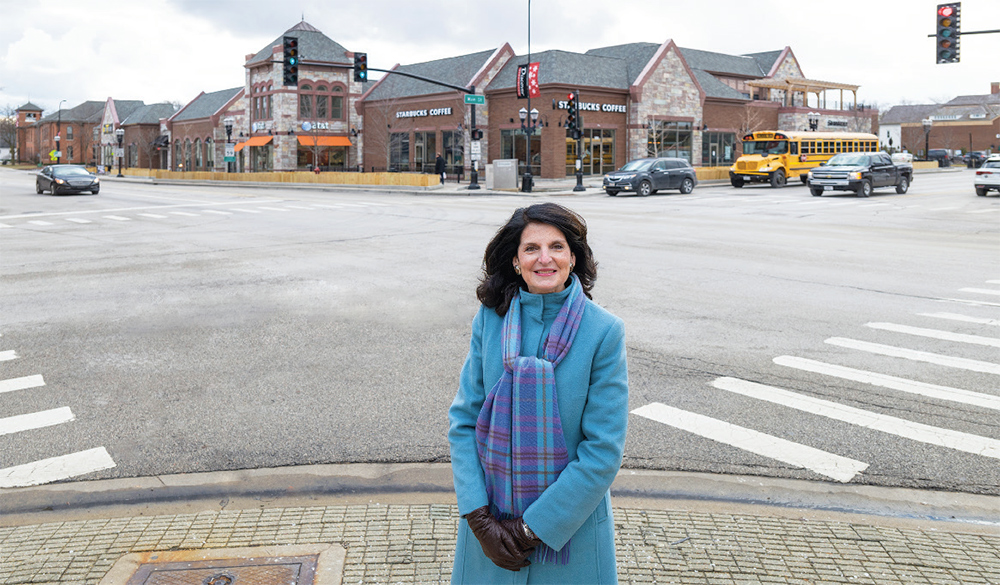
Karen Darch, Village of Barrington President
Village of Barrington Today and Tomorrow
A Letter from the Village President
Just five years ago in 2015, the Village of Barrington celebrated its 150th birthday—its Sesquicentennial. Having been founded as a small pioneer village in 1865, “the Village,” as it’s fondly known, sits at the center of the 90-square-mile Barrington area and is the commercial, cultural, and community heart of the region with its quaint shops, restaurants, and cultural offerings at Barrington’s White House.
The Village is also home to the Metra train station, which has historically been used by hundreds of commuters each day from the Barrington area and other close-by suburbs in order to easily reach the City of Chicago and all its world-class offerings.
Each year (pre-pandemic), the Village of Barrington hosts numerous community events, including the Barrington Art Festival, Cruise Nights & Summer Fun Thursdays, several Wine Walks, the July 4th parade, fireworks, and “Brat Tent” festivities, Brew Fest, Uncork Barrington, and National Night Out, Scarecrow Fest, and the Holiday Festival.
In addition, more than 60 events are held each year at Barrington’s White House Cultural and Community Center, including the annual Barrington Town-Warming, which has drawn national keynote speakers including Wendy and Hank Paulson, Doris Kearns Goodwin, and Governor Chris Christie. Each year the White House hosts numerous other nationally and internationally renowned speakers, classical and contemporary musical performers, and visual artists throughout the season, helping to place Barrington on the map as the cultural hub of our region.
The 1898-era Barrington’s White House is on the National Register of Historic Places; it was purchased and meticulously renovated with private donations as a part of a 20-year downtown redevelopment vision that began in the late 1990s. In the past two decades, the downtown Barrington area has been completely remade to feature lively restaurants and nightlife spots, quaint shops, as well as mixed-use condo/retail developments including the Cook Street Plaza at Cook and Station Streets.
The Village Center development at Main and Hough Streets, built in 2015, has become a downtown anchor, with its bustling Starbucks on the corner, city-vibe restaurants Shakou and Neoteca, and the ever-busy Egg Harbor Café restaurant drawing visitors into town from around the area. And of course, Barrington’s hometown charm would not be complete without a visit to the nearly 100-year-old Catlow Theater across the street.
With its beautiful Victorian homes and large downtown historic district, the Village is very walkable for those who enjoy an afternoon or evening stroll into town, where it’s almost impossible not to run into someone you know.
With its many large parks, run by the Barrington Park District, and vast open spaces in the outlying areas, Barrington is also a destination for recreationalists, who use it as a starting point for hikes, cycling excursions, cross-country skiing, and other outdoor pursuits. A commitment to the environment has always been central to Barrington’s vision, with numerous groups partnering with the Village on recycling efforts and projects to keep our green spaces and waterways clean and environmentally friendly.
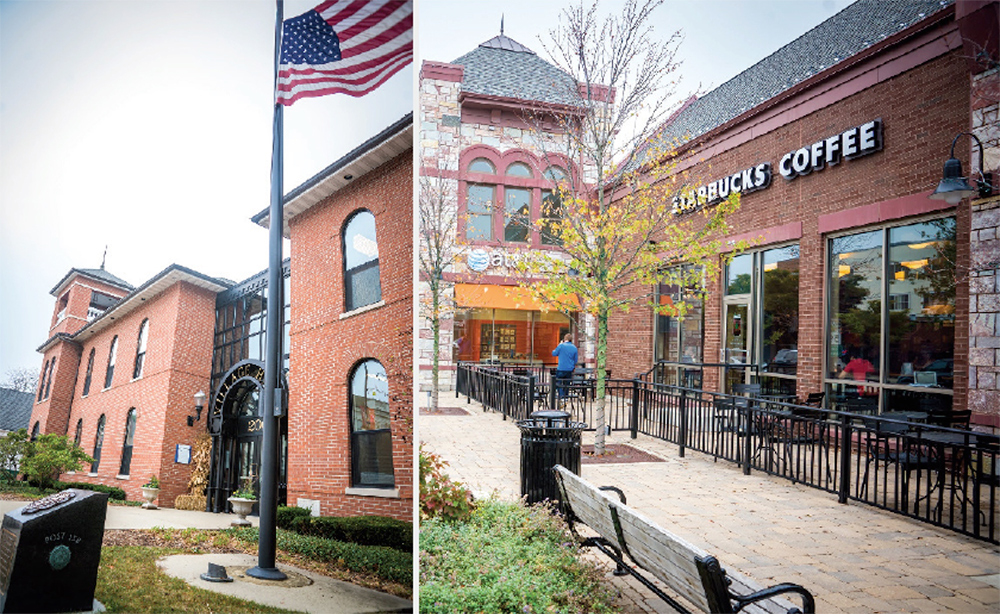
Left: Barrington’s Village Hall. Right: Barrington’s Village Center includes retail stores and restaurants.
Barrington’s Frontline Heroes
And of course, the Village of Barrington prides itself on providing exceptional Public Safety and Public Works services, including very responsive Police and Fire Departments that handle nearly 11,500 calls per year from residents in our service area. Our Public Works crews are the unsung heroes of the Village, keeping our roads patched and plowed, keeping our water and sanitary sewers clean, and keeping Barrington beautiful all year long with landscaping and tree planting programs that set our Village apart.
There is always a lot happening in the Village of Barrington, where residents are engaged and very giving of their time, talents, and resources through the many nonprofits and charitable organizations that call Barrington home. We are a truly “inspired” community, just as our tag line, “Barrington – Be Inspired,” suggests.
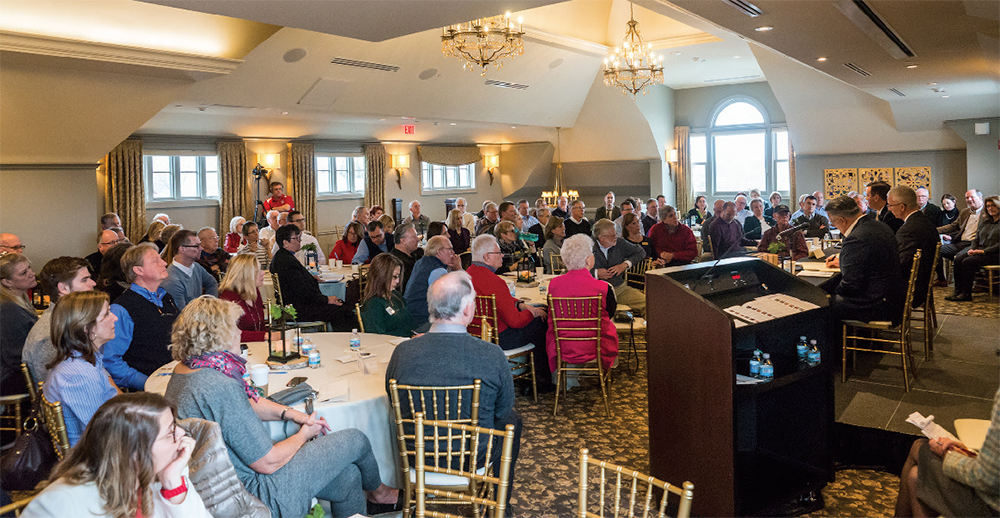
The revival of the Town Warming from the mid-1930s to early 1940s has been a welcome and successful annual event.
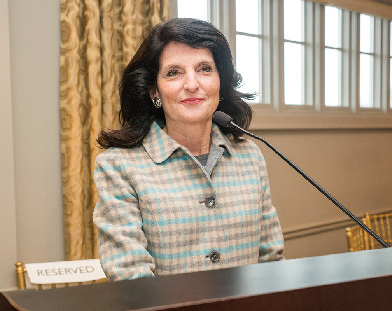
Meet Village President Karen Darch
by Patty Dowd Schmitz
Barrington’s Village president for the past 15 years has been Karen Darch. Karen has lived in Barrington for 35 years; she and her husband, Doug, have six grown children, all of whom attended Saint Anne School and Barrington High School.
From her earliest days as a Barrington resident, Karen knew that she wanted to get involved in her community. She was impressed by how much “giving” she saw from Barrington residents, and so she joined the Barrington Junior Women’s Club (BJWC), which was a great way to meet people and get involved. Her neighbors brought her to her first meeting, and to this day, she counts as some of her best friends those she met early on at BJWC.
She served as BJWC’s president from 1993-94 and as president of the Saint Anne PTO from 1999-2000. She has served in many of the other community organizations over the years, including the Good Shepherd Hospital Development Council.
She became a Trustee for the Village of Barrington in 1995. With her background as an attorney and due to the good example of her father, who had served on the board in her Connecticut hometown, she became engaged in Village government.
“I love the Village of Barrington because people are so involved and passionate here,” says Karen. “It’s just such a lovely hometown village outside the great City of Chicago, which is easily accessible by train. It has wonderful open spaces and a charming downtown, which makes it a terrific place for families and individuals of all ages.”
A Vision for the Future
Karen Darch has a vision for the future of Barrington that includes continued, low-density economic development to keep Barrington vibrant and strong, both in the downtown area and in the outlying corridors, such as along Route 14.
Continued investments in infrastructure are also at the top of the list, including road, sidewalk, and streetscape improvements, as well as the Route 14 underpass project at Lake Zurich Road that has been over a decade in the making, with construction beginning in late 2022. Ongoing support of environmental initiatives is also important to the Village, as it has become clear how the Village of Barrington’s low-density housing, charming, walkable Village, and open spaces are highly sought-after by former city dwellers and families alike.
A Comprehensive Plan
The Village is completing its 2020 Comprehensive Plan, a roadmap for the next 10 years that will guide the Village of Barrington’s efforts in these areas. The Comprehensive Plan was developed with significant community input in the form of an all-resident survey in January 2019 as well as a year’s worth of neighborhood open meetings where feedback and direction were sought and encouraged.
“While I realize that 2020 has brought many changes to all of our lives, I think it has confirmed what a special place Barrington really is,” Karen says. “We have seen significant strength in residential real estate sales in the Village, which was even noted by a recent article in Crain’s Chicago Business regarding home sales doubling in our area this summer after the pandemic struck. This is a testament to Barrington’s commitment to ensuring that it is a charming, safe, vibrant, and wonderful place to live. I am looking forward to the next 10 years and beyond.”
- Sidebar -
Village of Barrington By the Numbers (2019)
33 Years Designated a “Tree City USA”
560 Parkway Trees Planted or Trimmed
1,357 Tons of Recycling Material Collected in 2019
35 Years Received Certificate of Achievement in Financial Reporting
97.2% Retail Occupancy Rate in 2019
54,550 People attended 109 Village events, including 80 at Barrington’s White House
$1.2 million Donations Raised in 2019-2020 Specifically for Capital Reserve Campaign for Barrington’s White House
9,510 Police Department Calls for Service
4.85 Police Satisfaction Score (out of 5.00)
1,988 Fire Department Calls for Service
831 Building Permits Reviewed and Approved
1.3 Million Gallons of Water Pumped Per Day
– End –
Share this Story

